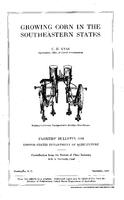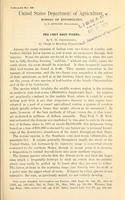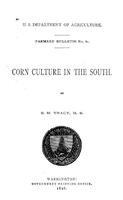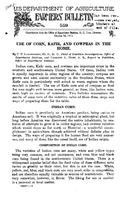Browse Items: 6
Page 1 of 1
Corn Culture in the Southeastern States
The recommendations and suggestions made in this bulletin apply firstly to the cotton-growing sections of North Carolina, South Carolina, Georgia, Florida, and Alabama.
Drainage and coarse stable manure should be used to prevent the irregular patches in the field in which little or no corn grows.
More of the rainfall is retained when the land…
Drainage and coarse stable manure should be used to prevent the irregular patches in the field in which little or no corn grows.
More of the rainfall is retained when the land…
Growing Corn in the Southeastern States
In the southeastern states larger yields of corn will be produced at less cost by giving greater attention to the following factors:
(1) Drainage and humus.
(2) Deep preparation of the land.
(3) Judicious use of commercial fertilizers.
(4) Special corn machinery.
(5) Adjustment of the cultural method to meet the special requirements…
(1) Drainage and humus.
(2) Deep preparation of the land.
(3) Judicious use of commercial fertilizers.
(4) Special corn machinery.
(5) Adjustment of the cultural method to meet the special requirements…
The Corn Root-Worms
The second species is the Southern corn root-worm (Diabrotica 12 punctata 01). It occurs generally throughout nearly the whole of the United States, but fortunately its injurious range is somewhat closely restricted to the southern States, though in recent years it is showing a disposition to extend depredations into more northern regions.
The…
The…
Corn Culture in the South
The South has special advantages for the raising of corn, in the long season during which it may be grown and in the ready sale for the crop at remunerative prices. Planting may be done as early as February in the Gulf States, or it may be deferred until after a crop of oats or clover has been gathered from the land in June. Killing frosts rarely…
Use of Corn, Kafir, and Cowpeas in the Home
The cowpea is a member of a large botanical family known as the Leguminosse, whose fruit or seeded pods are called legumes. It is said to be native to Africa and early in the eighteenth century was introduced into the United States by way of the West Indies. Gradually it spread northward and late in the century we have record of its cultivation as…
Increasing the Yield of Corn
When we consider that Alabama alone cultivated, in 1907, 2,961,000 acres in corn with an average of only 15 1-2 bushels to the acre, it at once becomes apparent that something must be done to bring up this unfortunately low yield per acre. It is further accentuated from the fact that within the last ten years the average has never been higher than…
Page 1 of 1
 An official website of the United States government.
An official website of the United States government.







